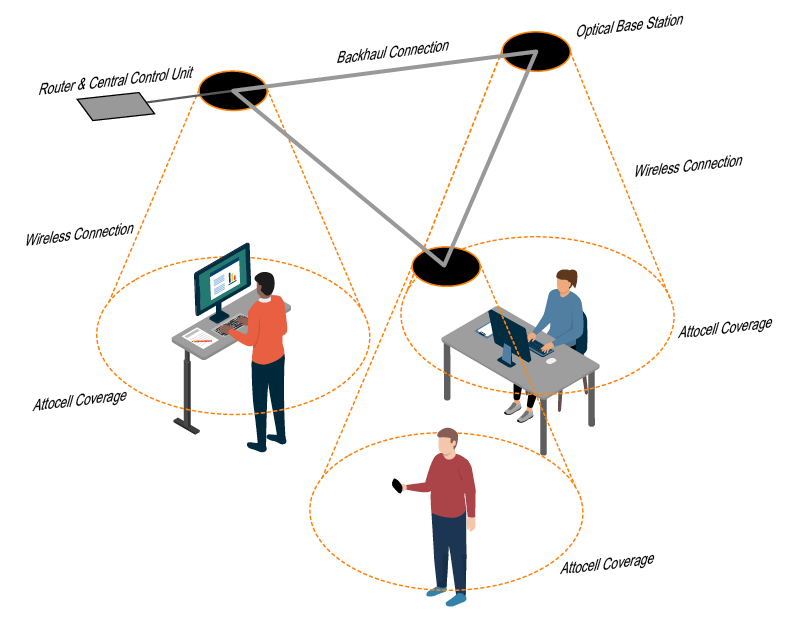Beyond 5G
TeraView is the pioneer and world leader in the development and commercialisation of terahertz technology, with applications with over 30 years’ unique experience operating at THz frequencies. TeraView has a vision to use its expertise and intellectual property to develop the building blocks of future 6G networks. To make this vision a reality, TeraView seeks partnerships with other companies and organizations with backgrounds in existing wireless communications markets. Since its inception, TeraView’s goal has been to make terahertz ubiquitous in everyday life.

6G - Drivers
The exponential growth in demand for high bandwidth applications such as multimedia streaming, the Internet of Things and cloud computing has triggered the need for development of new technologies providing high-bandwidth, reliable links in wireless environments. This growth has recently been accelerated by thousands of schools and businesses world-wide that have moved their operations online as a result of COVID-19. High speed, wireless technology will increasingly be an important component of the solution to the problem of enhancing connectivity. To address this challenge, emerging 5G and planned 6G wireless platforms will use progressively higher frequencies in the 100 gigahertz (GHz)-1 terahertz (THz) range to achieve 1 terabit (1012 bit) per second data rates required for broadband. By way of example, a recent report stated: “It is not surprising that the THz band has become the promised land for the envisioned next generation of wireless communication—6G”. [Link]

Figure 1: The location of the terahertz region in the EM spectrum
6G - Requirements
Development of devices, circuits, materials and wireless architectures at 6G frequencies requires test & measurement equipment operating in the terahertz region, and optimised for materials and system characterisation. Examples include:
- Understanding line-of-sight and non-line-of-sight propagation of 6G signals in different environmental conditions – e.g. in offices, outdoors, in large venues and under different ambient conditions.
- Measuring absorption and dispersion of a wide range of materials in these environments.
- Characterising the dielectric properties of materials in 6G devices & circuits, in intelligent beam steering platforms and in other aspects of 6G architecture.


Figure 3: Dielectric mechanisms
Measurement Systems
Existing measurement systems based on vector network analysers (VNAs) provide continuous frequency coverage up to only ~100 GHz, and with limited (banded) coverage available thereafter. Such systems are prone to errors in measuring quantities related to the phase of data stitched between different frequency bands. They are also susceptible to errors arising from the size & geometries of small samples. For example, interference from standing waves means that VNAs are limited to the study of thick (> ~7 mm) samples only in many instances.
TeraView’s 6GSolve system, provides the solution to these challenges. Using time domain measurements that continuously and simultaneously cover frequencies in the ~30 GHz-3 THz band with high dynamic range, this technology has been successfully used to characterise the propagation properties of 6G signals and the dielectric properties of a wide range of materials. Moreover, samples as thin as < 100 µm can be characterised using the TeraPulse system.
The system provides information on the real and imaginary part of the dielectric constant and the loss tangent of materials in both transmission (S12) or reflection (S11) modes. It provides a non-contact measurement of the complex conductivity of a variety of materials including, office materials, graphene, Teflon® and various meta-materials.

Figure 4: TeraPulse Lx Core Unit used in 6GSolve
TeraView’s Unique Position
As the pioneer in the commercialisation and development of terahertz systems, TeraView is in a unique position to provide 6G test & measurement solutions and systems. TeraView has over 3 decades of experience working at 6G frequencies, resulting in over 100 peer reviewed publications, which is made available to our customers in terms of on-going, collaborative support and ventures. TeraView is interested in working directly with customers and collaborators to develop 6G devices, systems and architecture.
6GSolve – The Test & Measurement Tool For 6G
6GSolve is a portable, modular system that gives the user both flexibility and expandability for test & measurement using free space terahertz pulses in the range 30 GHz - 3 THz. User-exchangeable plug and play modules allow for easy reconfiguration or extension of measurements. All systems include TeraView’s patented laser-gated photo-conductive emitters & detectors, as well as patented optical delay line/single laser system so that any phase jitter is minimised through common mode rejection.
The system is driven by an ultrafast (90 fs) laser supplied by Calmar Laser to provide broad frequency coverage and unprecedented stability.
The system includes TeraView’s TeraPulse core unit, which has an extensive track record of operation in the field in different applications. Transmission (S12) and reflection (S11) measurements in free space are supported via an easily configurable sample mount for the device under test (DUT), illustrated below in figure 5.
The system is designed to enable S12 and S11 measurements in a straight-forward manner once the DUT is mounted.

Figure 5: User configurable module for S12 and S11 free space measurements
The 6GSolve System
The 6GSolve system is comprised of:
- A core TeraPulse unit that is lightweight and portable, and is available in
desk-top format (433 x 450 x 222 mm). - Remote heads (emitter & receiver, placed up to 2.8 m from core unit) for configurable transmission (e.g. S12) or reflection (e.g. S11) measurements.
- A free-space s-parameter module that allows for manipulation of emitter and detector beam paths for transmission and reflection measurements.
- Software package optimised to return accurate information on complex dielectric and conductivity.
- Samples thicknesses from 0.1 to 7 mm.
Performance Specifications
Measurements: Coherent measurement of amplitude and phase
Spectral range: ~ 40 GHz - 3 THz, with down to 30 GHz targeted
Peak dynamic range: > 95 dB
Spectral resolution: Better than 5 GHz, user selectable, with 1 GHz targeted
Measurement time: Typically < 10 seconds
Quantities measured: Complex conductivity, complex dielectric and loss tangent, absorption and refractive index
Customer Case Study – Teflon®
A TeraView customer wanted to characterize the frequency response of a new type of fluoropolymer, related to Teflon®. Teflon is a key material for 6G because it used extensively in computer cables, smart devices, wearables and in printed circuit boards. Its superior dielectric properties and low dissipation factors provide ultra-high frequency and high-speed performance. The customer stated that they ‘needed a dielectric test system to characterize their Teflon material to 1 THz, to test their material at a given frequency and its first and second harmonics’. The conventional VNA system was seen by the customer as ‘cumbersome to use and requires us to change the test fixture for each frequency range. We would rather have equipment that handles broad range of frequency with no change in fixtures’.
The customer approached TeraView because they were aware that a terahertz time domain systems (TDS) was a possible solution to provide continuous coverage without the need for change of test fixtures. Results are shown which plot the dielectric constant, ε’, against frequency for transmission through Teflon samples using both third party VNA and TeraView solutions.
Because of the limited (banded) frequency coverage of the VNA system, coupled with the added need in this case for the use of waveguide structures to couple into the Teflon which further reduces the frequencies available, the VNA data (see individual points on the graph) is extremely limited.
By contrast, TeraView’s technology suffers no such limitations, and is able to show data continuously between ~ 30 GHz - 3 THz and beyond. Moreover, the ease of implementing test fixtures meant this approach could be used to study a wide range of parameters affecting material performance, including temperature; in the example below, temperature dependence of the Teflon dielectric constant, ε’, is shown, whereas this was not possible with the VNA-based system.

Figure 6: Dielectric constant ε’ (inc. data from Du Pont 2015)